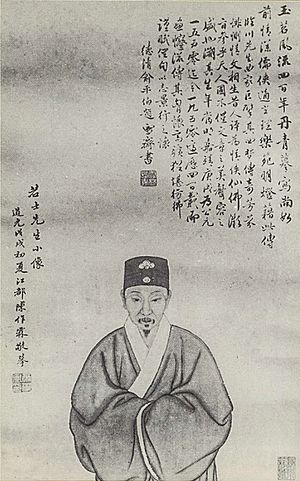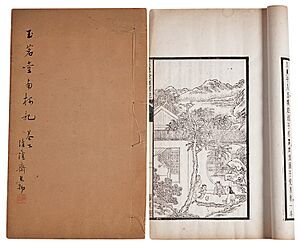Tang Xianzu facts for kids
Quick facts for kids Tang Xianzu |
|||||||||||||||||||||
|---|---|---|---|---|---|---|---|---|---|---|---|---|---|---|---|---|---|---|---|---|---|
 |
|||||||||||||||||||||
| Traditional Chinese | 湯顯祖 | ||||||||||||||||||||
| Simplified Chinese | 汤显祖 | ||||||||||||||||||||
|
|||||||||||||||||||||
Tang Xianzu (traditional Chinese: 湯顯祖; simplified Chinese: 汤显祖; September 24, 1550 – July 29, 1616) was a famous Chinese writer of plays during the Ming Dynasty. His special name, called a courtesy name, was Yireng (義仍). He is best known for his amazing plays, especially a group of four plays called the Four Dreams.
Contents
About Tang Xianzu
Tang Xianzu was born in Linchuan, a city in Jiangxi, China. He had a career working for the government. He started in lower-level jobs.
He was very smart and passed important exams. At 21, he passed the provincial exams (called juren). At 34, he passed the even harder imperial exams (called jinshi). These exams helped him get government jobs.
He worked in different places like Nanjing and provinces such as Zhejiang and Guangdong. In 1598, he stopped working for the government. He went back to his hometown. There, he spent his time writing plays. Tang Xianzu passed away in 1616. This was the same year that the famous English playwright William Shakespeare also died.
His Famous Plays: The Four Dreams
Tang Xianzu's most important plays are known as the Four Dreams. They are called this because dreams are a very important part of the story in each play.
These plays are still performed today. They are often shown on the Chinese Kun opera (kunqu) stage. Kun opera is a very old and beautiful style of Chinese theater.
His most famous play is Mudan Ting, which means The Peony Pavilion. Many people think it is his best work. The Peony Pavilion has been translated into English many times. This means people all over the world can read and enjoy his stories. In 2014, all his plays were translated into English and published in China. They were also published in London in 2018.
Tang Xianzu's Influence
After Tang Xianzu, some other playwrights from the Ming and Qing dynasties liked his writing style. They followed his way of writing. These writers even called themselves the Yumintang or Linchuan school. This shows how much he influenced other artists.
His Main Works
Here are the names of his most famous plays:
- The Purple Flute (Chinese: 紫簫記; pinyin: Zǐxiāo Jì)
- The Purple Hairpin (Chinese: 紫釵記; pinyin: Zǐchāi Jì)
- The Peony Pavilion (Chinese: 牡丹亭; pinyin: Mǔdān Tíng)
- Record of Handan (Chinese: 邯鄲記; pinyin: Hándān Jì)
- Record of Southern Bough (Chinese: 南柯記; pinyin: Nánkē Jì)
Works Available in English
Many of Tang Xianzu's works have been translated so English speakers can read them. For example, The Peony Pavilion and A Dream Under the Southern Bough are available. His complete dramatic works have also been translated into English.
See also
 In Spanish: Tang Xianzu para niños
In Spanish: Tang Xianzu para niños


